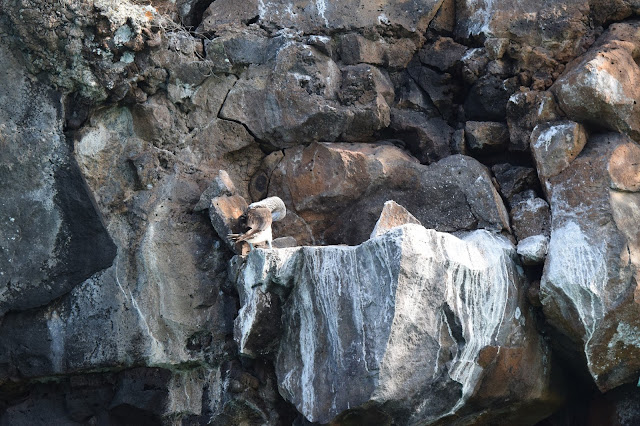You are also welcome to visit my classroom website at: Mr B's Classroom Website
Once at the tip of South Seymour, I took a small boat to a larger one that would take me to North Seymour. Overall, the waters were calm and the trip (~45 mins) was relaxing, When we arrived at N. Seymour island we disembarked onto a smaller boat in order to come ashore on the island. Interestingly, just before boarding the dinghy, I saw a large Galapagos shark circling the boats... neat! The terrain was rocky with ancient lava, hot coral rich sand, crashing waves, and low bushy vegetation. Despite the extreme heat and sun it became clear why this place was a naturalist's paradise.
One of the popular attractions is the fact that this island is a breeding and nesting area for several large populations of blue-footed boobies and frigatebirds (also swallow-tailed gulls and common noddies). As I walked along the rocky path, I witnessed a yellow land iguana, several baby sea lions (note: all sea lions that I've been seeing are California Sea Lions), and many many birds.
The blue-footed boobies had nest on the ground. Only one time did I see their eggs. I should also mention that these birds nest only on the ground. These birds will typically lay 2-3 eggs; however, whichever chick hatches first, it will kill the other(s) to survive; this is called, siblicide. It's still unclear by scientists why their feet at maturity are blue. It is known that it's some type of pigment and when the bird dies - the blue from the feet fades away according to my guide. I did see a few times the male boobie "dance" to attract a mate by simply lifting his feet up and down in a "soft" march. The red-footed boobie is only found on Isabella island and the masked-boobie is found on a nearby island and on the north part of San Cristobal island that I was not able to go to today.
The frigatebirds were equally entertaining. The males with their red pouches made sounds to announce their breeding intentions to females. I also saw several juveniles waiting for their parent(s) to return to feed them while they stayed in their nest. A few stood up to practice their flying abilities, too. They typically lay only 1 egg in which their nest are up off the ground in a bush.
Nevertheless, there were 100's of birds on the island and it was extraordinary to see them in their natural habitat in which humans can literally stand inches from the animals without the birds being afraid.
After a nice lunch on the boat... I took some time to visit a white sandy beach for about an hour (sorry decided to make my last visit to a Galapagos beach camera free). However, while swimming in the surf, I was being watched by a few sea turtles that seemed as interested in me as I was of them. Along the beach, rangers had placed several warning signs where sea turtles had laid their eggs recently. Lastly I saw a marine iguana swimming in the shallow water along the beach towards a layer of lava rocks - it was a nice ending to a wonderful experience on the Galapagos Islands!
Galapagos Shark
An idea of the terrain on the island with a blue-footed boobie grooming himself.
Several juvenile frigatebirds sitting on their nest in this hot and bushy terrain.
Close up of one of the juvenile frigates
I believe this to be a male Boobie. Both genders have yellow eyes; however, males have a smaller pupil and females have larger pupils. Fun fact, they get their name from the Spanish word, "bobo" which means fool or clown. Early Europeans probably noticed their clumsiness on the ground which characterized them as looking stupid.
Common Noddy with egg nestled in the cliffs
Male Frigatebirds (ones with the red pouch) courting a female. Listen to the sound they make towards the end of the video,
Blue-footed boobie with eggs. These birds have also been know to use their electric blue feet to warm their eggs since blood flows threw their feet.
Swallow-Tailed Gull with chick noticed while patrolling the side of the island in a dinghy
Male boobie performing his "strutting march" to attract a female... seemly successfully I would say
Epilogue
Having witnessed several of the same plants and animals (and geology) that Darwin noticed, documented, and collected has only made me appreciate and accept natural selection and the evolutionary process even more. To deny that these processes do not occur only inhibits ones understanding of biology and the wonders of nature and time. Evolution is one of nature's most greatest accomplishments, To be able to share my Galapagos adventure with my students (colleagues, friends, and the community) via this blog reminds me of why I love teaching. Having the opportunity to teach topics that interest me; such as, natural selection and evolution, allows me to share my passion of biology with others. I am convinced that having had the opportunity to experience such wonders as the Galapagos, more substantial discussions, meaningful activities, and passion for the life sciences will resonate from my students for years to come.
A great explorer and naturalists once wrote...
It is not the strongest of the species that survives, nor the most intelligent that survives. It is the one that is most adaptable to change.
On the Origin of Species, November 24, 1859
Thank You for Following and Enjoying the this Once in a Lifetime Experience
If You are Interested in More Photos and Videos, Please Visit the Following Website Link
Classroom Website


















































